

Herbaria Mundi: An image centric approach to manipulation of specimens from multiple collections. Herbaria Mundi. Structure and responsibilities of a #digextspecimen - Digital/Extended Specimen - GBIF community forum. Botanical Plant Illustration – LinBi. A brief introduction to drawing trees Botanical illustration is a discipline of visual communication, based on artistic techniques whose main goal is to represent a plant in the most accurate way to display its essential features.
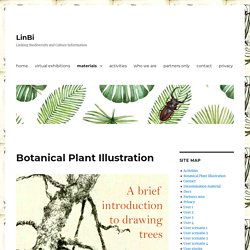
The library of the Real Jardín Botánico (RJB) has located, identified, described and organised a collection of more than 70,000 botanical illustrations, drawn from of a collection of our most valuable, ancient and special books. Various eras, artists, styles and printing techniques are well represented in this impressive botanical collection, which is now available on the internet. You can now locate these illustrations of plants and fungi via the main European digital heritage platform Europeana or via the RJB Digital Library website.
We encourage you to explore and consult the digital collection of botanical illustration, to (re-)use the contents in projects of any kind which might benefit from such documentation. Connecting molecular sequences to their voucher specimens. Reflections on TDWG 2020 Virtual sessions and other thoughts on long term data infrastructures – DiSSCoTech. This year the annual conference of the Biodiversity Information Standards (historically known as the Taxonomic Databases Working Group — TDWG) is virtual and happening in two parts.
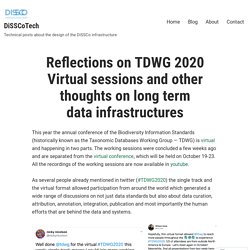
The working sessions were concluded a few weeks ago and are separated from the virtual conference, which will be held on October 19-23. All the recordings of the working sessions are now available in youtube. As several people already mentioned in twitter (#TDWG2020) the single track and the virtual format allowed participation from around the world which generated a wide range of discussions on not just data standards but also about data curation, attribution, annotation, integration, publication and most importantly the human efforts that are behind the data and systems.
The Life and Death of Data. Converging Digital and Extended Specimens: Towards a global specification for data integration. Bionomia. Towards a National Collection. Making IIIF the norm for natural history collections. Diddling with semantic data: linking natural history collections to the scientific literature. A couple of weeks ago I was grumpy on the Internet (no, really) and complained about museum websites and how their pages often lacked vital metadata tags (such as rel=canonical or Facebook Open Graph tags).
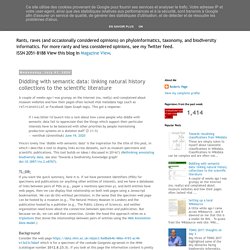
This got a response: If I was bitter I'd launch into a rant about how come people who diddle with semantic data fail to appreciate that the things which support their particular interests have to be balanced with other priorities by people maintaining production systems on a skeleton staff 😉 (1/3) — vsmithuk (@vsmithuk) June 19, 2020 Vince's lovely line "diddle with semantic data" is the inspiration for the title of this post, in which I describe a tool to display links across datasets, such as museum specimens and scientific publications.
This tool builds on ideas I discussed in 2014(!) (Rethinking annotating biodiversity data, see also "Towards a biodiversity knowledge graph" doi:10.3897/rio.2.e8767). If you want the quick summary, here it is. Background Magic happens. Resources for Working with IIIF Materials. A wish list for images of specimens in natural history collections. Herbaria Mundi Concept Overview. IIIF @ RBGE. Reuniting 3 of Nathaniel Wallich's collections. Magnolia pterocarpa Roxb. as drawn by one of his artists from @Kew_LAA, specimen collected by him from @NHM_London and letter from the same period applying for his return to England from @britishlibrary. #co. Deep Discoveries: A new way of exploring and connecting digitised image collections - The National Archives blog. ‘Technology is best when it brings people together.’Matt Mullenweg, creator of WordPress Unifying national collections The way we access information in the virtual space is changing.
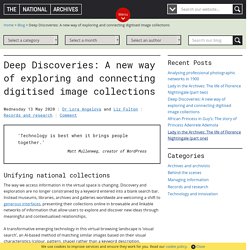
Conceptual design blueprint for the DiSSCo digitization infrastructure - DELIVERABLE D8.1. Article metadata 1.
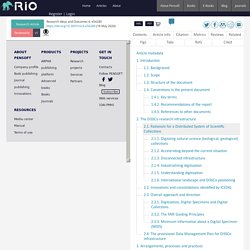
Introduction 1.1. Background 1.2. Scope 1.3. Structure of the document 1.4. Conventions in the present document 1.4.1. Article metadata 1. @Drypetes @RBGE_Plant_Rec @TheBotanics By why stop there? We have a @wikidata item for Olive Hilliard (referred to by @BloodhoundTrack @dpsSpiders ) so let's link that to her publications, and the taxa she has published on, e.g. Time to flesh out the #kno. Bloodhound. Uncovering the global picture of Open GLAM - Open GLAM - Medium. How many cultural heritage institutions make their digital collections available for free reuse?
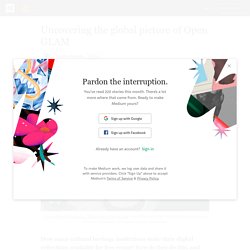
How do they do this, and where is open access most prevalent? Twelve months ago, Andrea Wallace and I set out to find some answers. In the first post in a short series, I recount the origins and motivations of the Open GLAM survey. For over a decade, the Open GLAM (Gallery, Library, Archive, Museum) movement has advocated open access to cultural heritage held in memory institutions, in order to promote the exchange of ideas and enable knowledge equity.
Open access has been embraced by a growing number of museums and libraries around the world, from New Zealand to Norway. Connecting data and expertise: a new alliance for biodiversity knowledge. It's finding the tools to link items in the collections. @TheBotanics herbarium (specimen) and archive (field image). and @NHM_Data and @KewScience and making links so that they are #collectionsunited. TaNC Social Media Statement. Herbaria Mundi.